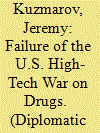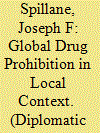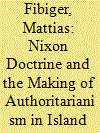|
|
|
Sort Order |
|
|
|
Items / Page
|
|
|
|
|
|
|
| Srl | Item |
| 1 |
ID:
183948


|
|
|
|
|
| Summary/Abstract |
Neoliberalism—a varied set of economic ideologies and policies that came to prominence in the late twentieth century—was closely linked to the global expansion of the national security state, a relationship best illustrated by U.S. drug control programs in Latin America during the 1980s and 1990s. A brief look at the history of U.S. drug control in the region demonstrates how neoliberalism entailed a reconfiguration, rather than a withdrawal, of the state’s authorities and capabilities. This essay explores the intersection of neoliberalism and drug control in U.S. foreign relations with Latin America through an example from Bolivia, tracing the mechanisms U.S. diplomats, policymakers, and politicians used to secure U.S. influence over foreign drug control and economic policies while revealing the contradictions of pursuing a militarized drug control approach within the context of a neoliberal economic program.
|
|
|
|
|
|
|
|
|
|
|
|
|
|
|
|
| 2 |
ID:
183946


|
|
|
|
|
| Summary/Abstract |
Shortly after his 2009 inauguration, U.S. President Barack Obama renewed the U.S. commitment to Plan Mérida, a $1.7 billion assistance program to Mexico, with a heavy emphasis on militarized policing modeled after Plan Colombia. With drones guiding military-police raids, the United States supplied Mexican law enforcement agencies with electronic signals technology, ground sensors, voice recognition gear, night-vision goggles, cell-phone tracking devices, data analysis tools, computer hacking kits, and airborne cameras that could read license plates from miles away.1 This aid was in addition to surveillance aircraft satellites, ion scanners, ballistic identification systems, and over a dozen Sikorsky Black Hawk helicopters that were deployed in a 2010 operation that supposedly killed drug kingpin Nazario Moreno Gonzalez (AKA “El Chayo”), though Nazario was reported to have been killed again in March 2014.
|
|
|
|
|
|
|
|
|
|
|
|
|
|
|
|
| 3 |
ID:
183947


|
|
|
|
|
| Summary/Abstract |
Cairo’s Qasr El Aini Hospital regularly received opiate addicts in poor health, but a startling new development in April 1929 captured the attention of Dr. Alexander Gordon Biggam, Director of the Medical Unit. Patients with a history of injecting heroin were being admitted with high fevers, and diagnored with falciparum malaria. Shocked by the prevalence of the disease, which appeared confined to networks of injection drug users, Dr. Biggam hypothesized—correctly—that the disease was being spread through contamined blood in shared syringes. “If the theory of the production of this malignant malarial infection amongst the heroin addicts is correct,” he concluded, “we are faced with a problem of considerable importance to the inhabitants of Cairo.”1 In the winter of 1932, a similar novel outbreak of malaria among injecting heroin users occupied Dr. Guy Henry Faget, an Assistant Surgeon at the United States Marine Hospital in New Orleans, a facility serving primarily merchant seamen. “If the hypodermic syringe must be accepted as a means of conveying malaria among narcotic addicts,” Dr. Faget warned, “then a new chapter in the epidemiology of this disease has been opened.
|
|
|
|
|
|
|
|
|
|
|
|
|
|
|
|
| 4 |
ID:
183944


|
|
|
|
|
| Summary/Abstract |
Confronted by a host of policy challenges in the summer of 1977, the new Jimmy Carter administration set about articulating its approach to U.S. drug control. Carter inherited from prior administrations, and would continue, a slate of policies centered on reducing heroin production in Asia and Latin America, particularly Mexico. Washington’s Mexico program posed a number of contradictions for the environmentalist and human-rights president. Abuses by Mexican soldiers and police during drug-control sweeps and Mexico’s use of herbicides to destroy marijuana generated controversy, but domestic drug policy likewise presented dilemmas. Between 1973 and 1976, seven states had decriminalized marijuana possession and candidate Carter’s remarks about reforming marijuana laws led supporters to soon expect a reversal of the country’s punitive approach to marijuana use. Carter’s main drug policy advisor, Peter G. Bourne, pushed for unequivocal federal-level decriminalization, but Carter and other advisors were concerned that Bourne was too dismissive of harm from marijuana. When the policy paper was finally released, many of Bourne’s draft statements, describing the harm from marijuana as “minimal” and marijuana prohibition as an “unhappy and misguided chapter” in U.S. history, were cut. Ultimately, Carter did not want the White House to be seen as advocating marijuana use.
|
|
|
|
|
|
|
|
|
|
|
|
|
|
|
|
| 5 |
ID:
183950


|
|
|
|
|
| Summary/Abstract |
President Richard Nixon arrived on the Pacific island of Guam in the late afternoon of July 25, 1969. Only hours after witnessing the splashdown of the Apollo XI spacecraft, Nixon spoke to reporters and articulated what came to be known as the Nixon Doctrine. The president focused his remarks on the need for a post-Vietnam War framework for American involvement in Asia. He argued that geography and history had fashioned of the United States a Pacific power, one whose interests and responsibilities stretched far beyond its western shores. And a Pacific power it would remain. Only the United States, Nixon insisted, could deter aggression by communist states like China, North Korea, and North Vietnam. But the president went on to explain that changes on both sides of the Pacific demanded a new American strategy. In the United States, the “frustration” wrought by the Vietnam War imposed limits on Americans’ willingness to bear the burdens of the defense of freedom abroad. Meanwhile across the Pacific, nationalist consolidation and economic development had rendered Asia far more secure, and the region’s people “no longer want to be dictated to from the outside.”1 These new circumstances, Nixon concluded, demanded a new policy: the United States would continue to furnish its Asian allies with the military and economic aid—but no longer the manpower—necessary to subdue threats that arose within their national borders.
|
|
|
|
|
|
|
|
|
|
|
|
|
|
|
|
| 6 |
ID:
183945


|
|
|
|
|
| Summary/Abstract |
Often dubbed “America’s longest war,” the U.S. War on Drugs has an even longer history than most observers realize.1 At the heart of that history lies a paradox; the drug war has failed, over and over, and yet it manages to persist. To its defenders, including generations of policymakers on both sides of the aisle, the drug war is a difficult but necessary campaign to protect the U.S. population from a scourge of addiction, crime, and foreign enemies. To its many critics, the War on Drugs is better described as a war on people and therefore a tool of imperialism, social control, and white supremacy. In that view, this so-called war looks less like a total failure and more like a wild success—a clash of interpretations that has major implications for the history and future of the drug war.
|
|
|
|
|
|
|
|
|
|
|
|
|
|
|
|
| 7 |
ID:
183949


|
|
|
|
|
| Summary/Abstract |
Since the late twentieth century, two United Nations organizations have monitored the global trade in drugs from their respective perches in Geneva: the Essential Drugs Program of the World Health Organization (WHO) and the United Nations Office on Drugs and Crime (UNODC). In 1988, the Essential Drugs Program published the first edition of the World Drug Situation, which narrates the many barriers preventing “essential” drugs (antibiotics, anti-epileptics, insulin, etc.) from successfully travelling from centers of production in the global North to arenas of potential consumption in the global South. The UNODC’s annual World Drug Report figures the opposite problem by policing “non-medical” drugs that are trafficked from centers of production in the global South to illicit consumer markets, some of the largest of which are in the global North.
|
|
|
|
|
|
|
|
|
|
|
|
|
|
|
|
| 8 |
ID:
183951


|
|
|
|
|
| Summary/Abstract |
Anthropologist Margaret Mead supported Point Four—at least at first. In January 1949, U.S. President Harry S. Truman had made the sharing of U.S. know-how with the rest of the world a pillar of his foreign policy agenda, ushering in a “cooperative” program of technical assistance and self-help. Under the perception that the rapidly shifting forces of modernity were on the march around the globe, Mead echoed her earlier scholarship when she advocated for development in the post-1945 era as akin to “education for choice”: allowing other cultures to “cope with modernity as much on their own terms as possible.”1 The head of Point Four, Dr. Henry Garland Bennett, a Progressive and former teacher, shared similar sentiments. In November 1951, he noted to a room full of fellow educators “the ferment” of the times. People around the globe now had a “window into the 20th Century,” Bennett argued. “They are looking for a door, and we are helping them to find one. We can do no less than welcome them as partners.” Mirroring Mead’s educational emphasis, he added: “The Point 4 Program is education, from first to last. It is in fact the essence of education: an adventure in the sharing of knowledge.”
|
|
|
|
|
|
|
|
|
|
|
|
|
|
|
|
| 9 |
ID:
183943


|
|
|
|
|
| Summary/Abstract |
Is the United States an empire? This question is less controversial among Americans than it was even a dozen years ago, but the greater willingness to call the United States an empire does not indicate agreement on its meaning. Those who have called the United States an empire have done so in order to stress the exploitative and violent nature of its policies. They have pointed to the contradiction of U.S. support of imperialism while touting commitments to democracy and self-determination. Other Americans who have adhered to a more exceptionalist vision of the United States cannot accept this interpretation. After all, the United States was established through an anti-colonial struggle. In their view, imperialism cannot exist without colonies, and by ignoring U.S. territories, they argue that the United States cannot be an empire because it has no colonies. But some of those Americans championing U.S. exceptionalism will accept the label of empire. They do so because they define empire to mean superpower and thus argue that their nation, empire or not, is “still a force for good” in the world.
|
|
|
|
|
|
|
|
|
|
|
|
|
|
|
|
|
|
|
|
|